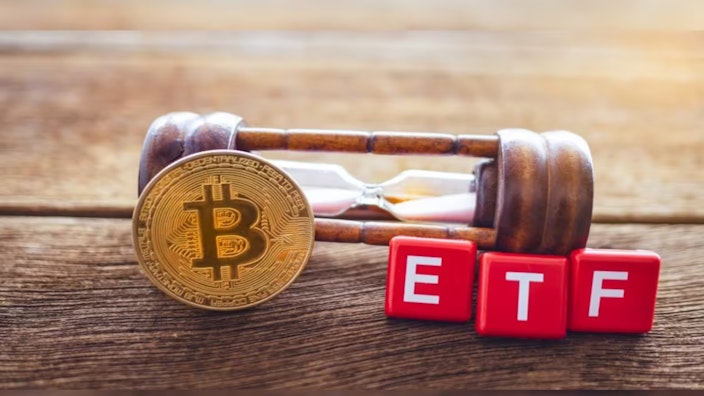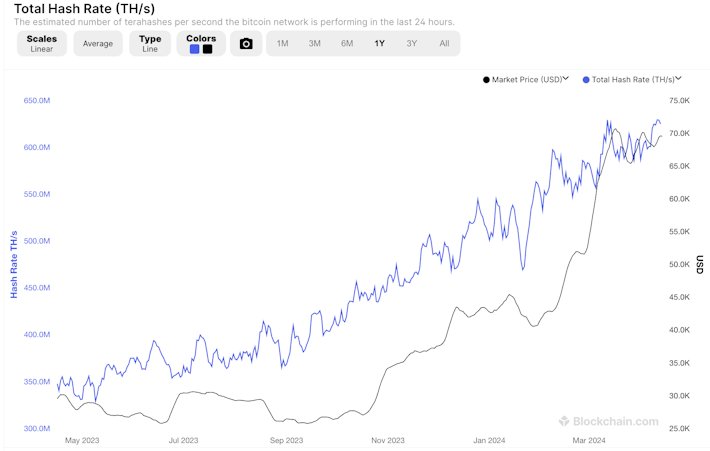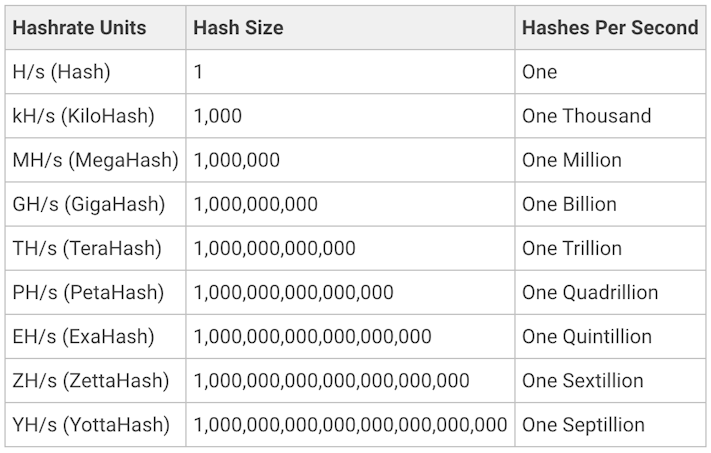What Is BTC Hashrate? Why You Should Care (May 2024 Update)
Bitcoin hashrate? Sounds confusing, but its not. Learn the role Bitcoin’s hashrate plays and why its important.


Bitcoin Hashrate is defined as the Bitcoin mining difficulty of the blockchain. It measures how difficult it is to mine a Bitcoin.
Hashing Process: A hash, an alphanumeric code, is randomly generated by the hash function. Bitcoin mining, also known as 'hashing, ' involves attempting to guess this code using a computer that submits these guesses to the blockchain.
Hashrate Measurement: Bitcoin hashrate measures how many guesses are submitted per second to the entire blockchain. A higher hashrate indicates the need for more computing power, increased energy costs, and longer verification and transaction times. This results in slower and more expensive Bitcoin mining.
Bitcoin Hashrate is measured in:
Billions
Trillions (a thousand billion)
Quadrillions (10^15)
Quintillions (10^18)
For example, according to Coinwarz, the current Bitcoin Hashrate as of May 15th, 2024, is 539.80 exahashes per second.
1 exahash is 1 quintillion (10^18) hashes per second. This means 688 quintillion guesses are being submitted to the blockchain every second.
Historical Comparison: On May 15th, 2023, the hashrate was 390.79 exahashes per second, indicating that it was almost 78% cheaper to mine Bitcoin just a year ago.
You can check out an interactive graph of Bitcoin hashrate in exahashes on Coinwarz.
1 exahash per second = 1 quintillion hashes submitted per second.
For viewing in terahashes, visit Blockchain.com.
1 terahash = 1 trillion hashes submitted per second.
Understanding these metrics helps to comprehend the complexity and cost associated with Bitcoin mining.
Understanding Bitcoin Hashrate
Hashrate is commonly defined as the speed at which a Bitcoin mining machine operates. In the context of Bitcoin, hashrate refers to the number of computations that hardware can perform per second as it works to solve the cryptographic puzzle.
As more miners join the network, the network hashrate rises. The higher the Bitcoin hashrate, the more difficult it is to attempt to attack Bitcoin.
How Hashrate Works
Bitcoin miners and hashrate are inexorably linked. Miners provide the hashrate to the network in exchange for the newly issued Bitcoin and transaction fees.
1) What is Bitcoin Mining?
Bitcoin mining involves adding new transactions to the blockchain and securing the network. Miners use powerful computers to solve complex mathematical puzzles, validating transactions. Miners are rewarded with newly minted Bitcoin for their efforts. Learn more about the Byzantine Generals Problem and mining costs.
2) What is SHA-256?
SHA-256 (Secure Hash Algorithm 256-bit) is the cryptographic algorithm used in Bitcoin mining. It transforms transaction data (block header) into a fixed-size hash value using proof-of-work.
3) What is a Nonce?
A nonce is a specific value miners must find to produce a hash with certain characteristics. It is a number used only once in the cryptographic process.
4) How Do Miners Find the Nonce?
Miners use trial and error to find the nonce. They continuously change the nonce value and run it through the SHA-256 algorithm until they find a hash that meets the required criteria.
5) What is a Block Time?
Bitcoin’s protocol adjusts mining difficulty every 2016 blocks (approximately every two weeks) to maintain an average block time of about 10 minutes. This ensures a steady and reliable rate of new block additions.
Miners are computers that perform the computations for the Bitcoin network. Hashrate represents the number of computations per second. As more miners join the network, the hashrate increases, making it harder for a single entity to affect the network.
Computational Guesses: Solo miners could spend years without solving a block and getting paid, due to the random nature of the computations.
Mining Pools: To mitigate this risk, many miners join mining pools. Pools combine computing power, raising the probability of solving a block and resulting in more frequent, smaller payouts.
Increased Probability: By pooling hashing power, miners improve their chances of solving a block.
Frequent Payouts: Participants in mining pools receive more regular, smaller payouts.
Lottery vs. Bond: Mining pools are like playing the lottery versus buying a bond, with the bond paying interest in Bitcoin instead of fiat currency.
Swan’s Yan Pritzker explains Bitcoin mining as a lottery system in this Twitter thread.
A high hashrate in the Bitcoin network:
Acts as a shield against potential attacks.
Safeguards the integrity of transactions.
Enhances the trust and reliability of the decentralized system.
As more miners join the network, the difficulty of mining adjusts to maintain a consistent block time. This mechanism:
Ensures smooth network operation.
Reinforces security by keeping mining competitive and resource-intensive.
A high hashrate implies substantial computational power dedicated to mining and processing transactions. This makes the network robust and secure against potential threats by making attacks cost-prohibitive.
When comparing Bitcoin’s price movement with its hashing power:
Bitcoin’s price fluctuates significantly.
Hashrate follows a relatively steady upward trajectory.
Some argue that:
Hashrate leads to price increases.
Miners position themselves for profits during price run-ups.
Understanding the correlation between hashrate and Bitcoin’s value provides insights into market dynamics and network security.
Some would argue that hashrate leads price, or even causes price to increase. Others may say miners are positioning themselves to make windfall profits when the price runs up inevitably.
Challenges and Risks
Regarding Bitcoin’s hashrate, it’s essential to be aware of potential risks that may threaten the network’s stability and security. Here’s a breakdown of some key risks to keep in mind:
1) 51% Attacks: Quelling the Majority Menace
Risk: A 51% attack occurs when an individual or group controls more than half of the network’s hashrate, granting them significant power to manipulate transactions or double-spend coins.
Such attacks can undermine the trust and integrity of the Bitcoin network, potentially leading to financial losses and a loss of confidence in the cryptocurrency.
Mitigation:
51% attacks are only possible if one entity, likely a mining pool, controls over half the hashrate.
Pool operators would need malicious intent, which would likely destroy the value they have created.
Switching mining pools is easy, so many miners would leave a pool if it approached 51% of the network power.
2) Contentious Hard Forks: Splitting the Blockchain
Risk: A hard fork happens when a protocol upgrade creates rules incompatible with the existing blockchain. Contentious hard forks occur when there is disagreement within the community about the changes, leading to a split and the creation of a new cryptocurrency.
These forks can cause confusion, disrupt transactions, and impact network security and stability.
They occur when there is a disagreement among the community about the proposed changes, leading to a split in the blockchain and the creation of a new cryptocurrency. These forks can cause confusion, disrupt transactions, and potentially impact the security and stability of the network.
The blocksize war, involving Bitcoin and Bitcoin Cash, revolved around the debate on the optimal block size limit for processing transactions.
Bitcoin Cash, which split from Bitcoin in 2017, increased the block size limit to improve scalability but has since become less relevant.
Mitigation:
Bitcoin’s strength lies in its decentralized nature and consensus mechanism.
During the blocksize war, influential entities like Coinbase and significant portions of the hashrate sided with big blockers. However, their efforts were thwarted by node runners and network users who stood firm in their refusal to accept the proposed changes.
Hashrate does not grant the power to control the network; users running nodes that maintain Bitcoin’s ruleset still hold significant power.
By understanding these challenges, Bitcoin users and stakeholders can better navigate and mitigate risks, ensuring the continued stability and security of the network.
How Bitcoin Hashrate is Measured
The BTC hashrate is typically calculated as hashes per second (h/s). The hash unit can be expressed by size:
By analyzing the time it takes to mine a block and the difficulty level of the network, one can estimate the total hashrate of the Bitcoin network.
Here are a few tools you can use to keep an eye on or analyze hashrate:
If you really want to dig in deep, Luxor’s Hashrate Index is probably your best bet.
At a glance, tools like TimechainStats can’t be beat, but with a good amount of functionality for those who want a little more.
For those who love summary visualizations, Time Chain Calendar is a good option for quick hashrate updates.
Bitcoin Hashrate History
The higher Bitcoin’s price goes, the more miners will want to join the network, further adding to the security and reliability.
Newest Episode: May 12th, 2024 — Bitcoin, Energy & Law with Justin Ballard
We dive deep into the intersections of law, energy, and Bitcoin mining with Justin Ballard, the host of the Digital Wildcatters podcast and a seasoned lawyer working with Archon. Justin shares his journey from an energy attorney to a pivotal figure in the Bitcoin mining space, discussing his company, Firm 21M, and his role in transforming energy assets into lucrative mining operations.
HashrateUp is a podcast that delves into Bitcoin mining and exciting projects, utilizing hashrate production to unlock new potentials in the broader energy industry.
FAQ Section
What factors can affect Bitcoin’s hashrate?
Factors affecting hashrate and mining profitability include Bitcoin price, block reward, difficulty, the cost of power, and geopolitical conditions. For example, after the halving, the block reward is cut in half, so many older miners may fall out of profitability and shut off, decreasing the hashrate. However, if Bitcoin’s price increases fast enough, those old machines may be profitable to turn back on, resulting in a subsequent increase in the hash rate.
What happens if Bitcoin’s hash rate decreases significantly?
If Bitcoin’s hash rate decreases significantly, it may take longer for blocks to come in than the 10-minute targeted average. Eventually, the network would reach the 2016 block limit and adjust the difficulty level accordingly. Depending on the degree of hash rate loss, this may have to happen several times to reach the 10-minute target — though slow block times would likely increase the demand for block space, resulting in higher fees and incentivizing more miners to join the network. The network is a self-licking ice cream cone of incentives that keeps things moving.
Can Bitcoin’s hashrate ever reach zero?
A zero hashrate would imply the world has ended. In this case, your diversification into guns, ammunition, and general doomsday prepper goods and services may eventually be helpful. In all seriousness, the answer to this question is probably not. Similar to questions about "what if the internet doesn’t work.” Well, then basically nothing else does either, so good luck accessing your bank account.
What if mining is banned in my country?
China banned Bitcoin mining in 2021, which is widely believed to have chopped the head off the 2020 bull run, so to speak. Since then, hashrate has nearly tripled, with foreign countries like Ethiopia experiencing the benefits rather than China. You can’t ban Bitcoin; you can only ban your country from benefiting.
Isn’t Bitcoin mining bad for the environment?
Bitcoin mining does not waste energy; rather, it puts economic value on wasted energy. Though hotly debated, those in the know understand that Bitcoin and Bitcoin mining have the potential to radically transform the world’s energy infrastructure into a cleaner, more reliable, and abundant energy system for everybody.
Simply put, Bitcoin’s hash rate is a representation of the network’s power and security.
Hashrate represents the backbone of Bitcoin — it powers the network and allows transactions to be securely processed, validated and added to the blockchain.
While the concept is technical, it provides valuable insight into the health and growth of Bitcoin. Monitoring hashrate provides critical data that analysts can use to assess the overall security and state of the Bitcoin ecosystem.
As Bitcoin continues to develop, its ever-growing hashrate is cementing its position as the most powerful and secure computational network in the history of the world.
On January 25th, Swan announced Swan Mining, a division of Swan Institutional.
Swan is currently mining over 7 EH/s. Equal to about 1% of the entire Bitcoin network. Whether you’re new to Bitcoin or a seasoned enthusiast looking to expand your portfolio with a Bitcoin IRA.
Swan is a leading Bitcoin financial services company with more than 120,000 clients and 170 employees, operating globally. Established in 2019, Swan helps individuals and institutions to understand and invest in Bitcoin. The Swan app simplifies Bitcoin purchases with instant and recurring buys. Swan IRA provides a tax-advantaged solution for saving Bitcoin in retirement accounts.
For HNWIs and businesses, Swan Private provides white-glove service for large purchases, treasury solutions, and employee Bitcoin benefits. With Swan Vault, clients can easily custody their own Bitcoin with peace of mind. Financial advisors trust Swan Advisor for client Bitcoin allocations, backed by world-class custody and educational content.
Swan Managed Mining provides clients with fully segregated and dedicated mining operations, catering to their unique requirements, opportunities, and strategic advantages. Swan prides itself on exceptional client service, making Bitcoin accessible to all. For more information, please visit swan.com.
Swan IRA — Real Bitcoin, No Taxes*
Hold your IRA with the most trusted name in Bitcoin.
Mickey Koss became a freelance writer in the Bitcoin space in an attempt to build a proof of work portfolio for when he left the Army. He graduated from West Point with a degree in Economics before serving in the Army for nearly a decade. He became orange pilled in graduate school and is now a regular contributor to Forbes, Bitcoin Magazine, and Bitcoin News. He’s been on popular podcasts such as BTC Sessions’ Why Are We Bullish, and is a regular on Café Bitcoin.
Drew, a class of 2013 Bitcoiner, is a Research Analyst for Swan Bitcoin.
He has worked in institutional VC/PE, FinTech, and DLT consulting for over six years. He also brings over twelve years of experience working with national nonprofits and start-ups in education and software development in several leadership roles.
More from Swan Signal Blog
Thoughts on Bitcoin from the Swan team and friends.


Epoch Five — Big League Bitcoin

By Tomer Strolight
Block 840,000 has come and gone. With it, came Bitcoin’s fourth halving, cutting the issuance of new coins to 3.125 per block. Welcome to Epoch V. What awaits us?


An Open Letter to Ann Barnhardt
By Arman the Parman
I decided to write a letter, then made it an open letter, to Ann Barnhardt.


Best Bitcoin ETF Fees: Lowest to Highest (May 2024)

By Matt Ruby
In this guide, we analyze and present the top 10 Bitcoin ETFs with the lowest fees for cost-effective investing.




